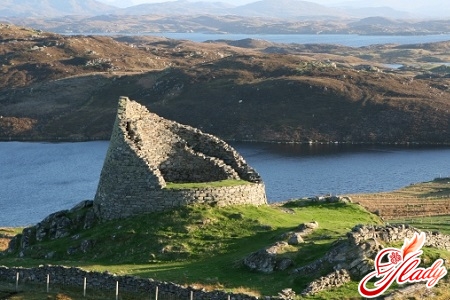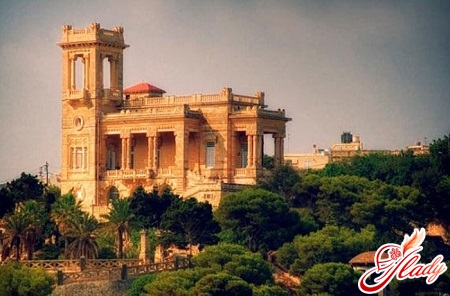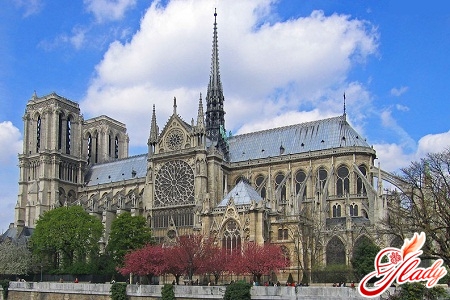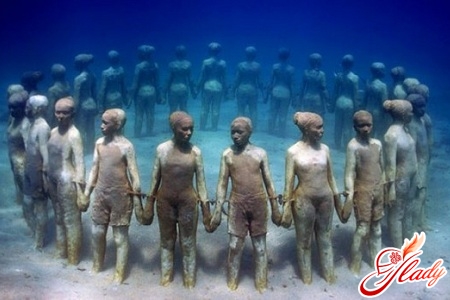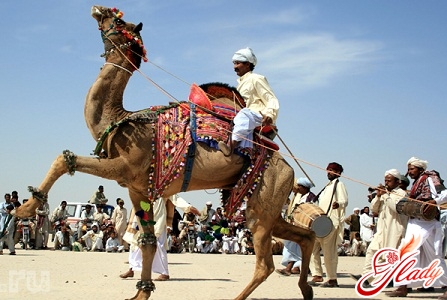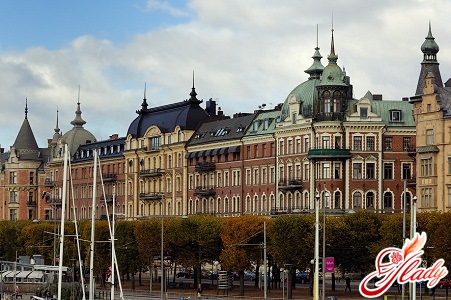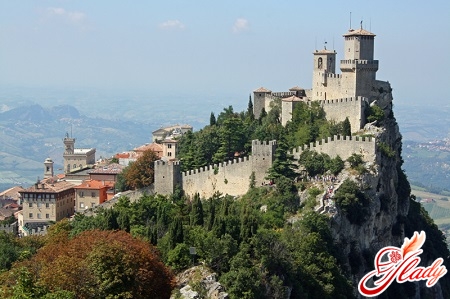
On the slopes of the three-peaked Monte Titano,Located in the north-east of the Apennine Peninsula, the tiny Republic of San Marino is hidden. Despite its more than modest size (61 sq. km), this dwarf state is one of the oldest in Europe. According to legend, it was founded at the very beginning of the 4th century by a member of the Christian community from the island of Rab, the stonecutter Marino, who, together with like-minded people, hid on the mountain peaks of Monte Titano, fleeing religious persecution. The only neighbor of the independent Republic of San Marino is Italy, which surrounds it on all sides. The San Marino people are a very proud people, throughout history they have never been conquered by any state. Every year about 2 million tourists come to the republic to see the sights of San Marino, the main part of which are centuries-old castles, perfectly preserved to this day. The 32,000 San Marinos, who make up the country's indigenous population, live in the tiny and fairytale-like beautiful towns and communes of San Marino, Domagnano, Faetano, Chiesanuova, Monte Giardino, Fiorentino, Acquaviva, Serravalle and Borgo Maggiore. Each of the settlements has preserved small squares with castles, remains of fortress walls and narrow long streets that wind between ancient buildings and terraces. Modern San Marino is like a real open-air medieval museum.
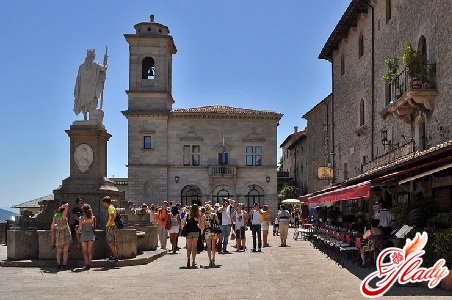
The most ancient buildings of San Marino
The country's main attractions are locatedin its capital - the city of San Marino. At the top of Monte Titano there is a complex of three ancient towers, the image of which can be seen on the coat of arms of the state, as well as on local euro coins. The oldest tower, called Guaita, was built in the 11th century and was used as a prison for a long time. Throughout its history, the tower has been rebuilt more than once. Its walls contain ancient artillery weapons, which Italy repeatedly donated to the San Marino residents in the 19th century. Guaita is a fortress structure consisting of two rings of walls and several turrets. On the southern side of the tower is a well-preserved chapel of Santa Barbara. Today, Guaita is open to tourists and is the most visited attraction in the country. The Cesta Tower, part of the famous tower complex, dates back to the 13th century. It is built on the highest point of Monte Titano. Its walls served as a fortification for the city for a long time. The gates of the defensive structure were erected in the 16th century. Like the Guaita Tower, the Cesta has been rebuilt many times, but this has not prevented it from preserving its original appearance. For more than half a century, the tower has housed the Museum of Ancient Weapons, whose exhibits include a collection of medieval armor and examples of weapons from different eras. The third tower of the complex, Montale, was built at the beginning of the 14th century. Built in the form of a small pentagon, for a century and a half it warned the townspeople of the danger emanating from the neighboring Fiorentino Castle. Today, this tower is closed to visitors.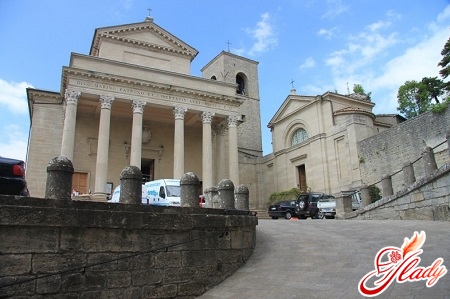
The main gate of the city and the Palazzo Publico
The Gate of St. Francis, through whichThe entrance to the capital of the state is carried out, were built in 1361. They served as a guard post for the townspeople. Later, the gates were completely rebuilt, and in 1581, external doors were added to them. On the inside of the gates are carved the coats of arms of San Marino and the noble ancient Feltresca family. An old sign has been preserved on the gates warning travelers not to bring weapons into the city. For failure to comply with this requirement, travelers faced severe punishment. Next to the city gates are the church and monastery of St. Francis, the completion of which dates back to the beginning of the 15th century. Describing the sights of the republic, it is impossible not to mention the Palazzo Pubblico - the government palace, the construction of which lasted for 10 years and was completed in 1894. The palace was erected according to the design of the architect from Rome Francesco Azzurri. The building belongs to the neo-Gothic architectural style. The right corner of the Palazzo Pubblico is decorated with a bronze statue of Saint Marino. The majestic palace is guarded by elegantly dressed guards, who are part of the state's military formations. In front of the palace is a small Liberty Square, in the very center of which stands the Statue of Liberty - a gift to the republic made in 1876 by the German Countess Wagener. Under the square, there are still cisterns that used to collect rainwater for the city's needs.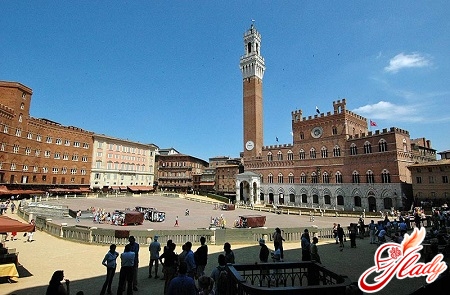
Basilica del Santo and the Church of San Pietro
Like Italy, San Marino is ancientis a Catholic state, and on its territory there are many religious buildings worthy of the attention of tourists. The Basilica del Santo, founded in 1838, is one of them. The cathedral of extraordinary beauty was built on the foundations of the Romanesque parish church of Pieve that stood here in ancient times. The majestic basilica, made in the neoclassical style, looks like an ancient temple. It is decorated with 6 Corinthian columns, with the help of which a high white portico is supported. In the temple you can see a rich collection of ancient paintings and sculptures. The main altar of the Basilica del Santo is decorated with a statue of St. Marino, its author is the sculptor Adamo Tavolini. Under the altar is kept the skull of the founder of the republic. You can visit the basilica every day, it is open to tourists both on holidays and on weekdays. On the right side of the Basilica del Santo is a small picturesque church of San Pietro. It was here that the relics of St. Marino were kept until the beginning of the 18th century. The central place in the church is occupied by the altar, decorated with magnificent marble inlay, which was donated to the temple in 1689 by the Italian musician Antonio Tedeschi. A majestic statue of St. Peter, made by the sculptor Enrico Salordi, rises above the sanctuary. In the rock behind the altar there are niches in which the remains of St. Marino and his like-minded and faithful friend St. Leo once rested. It is believed that these niches have healing properties. In the 19th century, the church of San Pietro was carefully restored, which allowed it to be perfectly preserved to this day.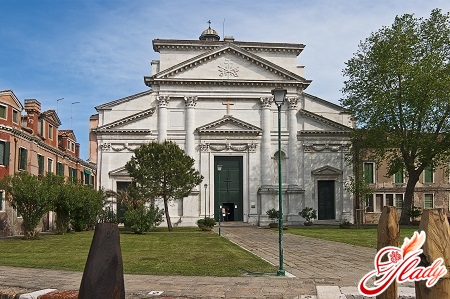
Famous state museums
As in any country with developed tourism,There are many different museums in San Marino. You should definitely visit the State Museum of the Republic, where you can get to know the history of this state better, see ancient archaeological finds and works of art by San Marino artists who lived in past centuries. The main part of the museum is located in the Bergami-Beluzzi castle. Near the museum there are 2 more attractions of the country: the Gallery of Modern Art and the Pinacoteca di San Francesco. The halls of the gallery present more than 750 works of art from the 20th to the beginning of the 21st centuries. The Pinacoteca exhibits paintings and sculptures from the 14th century and religious objects of the Franciscan order dating back to the 14th-19th centuries. At the foot of Mount Titano on the San Marino-Rimini road is the Museum of Vintage Cars, which is visited daily by crowds of tourists. The museum has 120 exhibits, among which you can see not only retro cars, but also modern racing cars. Fans of technology are attracted not only by this museum, but also by the Maranello Rosso automobile collection, which includes more than 250 examples of Ferrari cars. Despite the fact that the birthplace of these high-speed cars is Italy, the largest Ferrari collection in the world is located in San Marino. The collection displays the main stages of production of racing cars of this legendary brand. San Marino attracts with many unusual museums. When traveling through this mountainous country, you should pay attention to the only Museum of Curious Things in the world, as well as the Museum of Emigration and the Wax Museum. The most stress-resistant tourists can be advised to spend time in the Torture Museum, which contains more than 100 weapons used to torture people in ancient times. Among the attractions of the republic is the Museum of Modern Weapons, which on a large territory presents more than 1000 exhibits of weapons brought from different parts of the world. Fans of fauna will be interested in the Museum of Reptiles, located in the central part of San Marino. It contains exotic reptiles. Attractions in San Marino are festivals, annual crossbow shooting competitions, theater performances, meetings and other events that constantly attract attention to the state. The republic is no less popular with tourists than its neighbor Italy. Having arrived in San Marino, most travelers forget about the era in which they live, because everything in this country breathes the Middle Ages. It is not for nothing that famous film directors love to shoot historical films here. The main attraction of the country is the funicular, riding which you can see from a bird's eye view not only the entire territory of San Marino, but also the nearby Italian lands. Those who have ridden, claim that such an air journey is a breathtaking sight.




